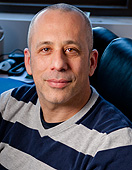News
Sharing patents with competitors
may encourage innovation
-
 Print
Print -
 Comments
Comments
-

“Innovation doesn’t just make innovators better off; it makes current consumers better off and it provides the nexus to the next technological breakthrough.”
Firms that make a previously patented innovation accessible to competitors increase the overall likelihood of improving upon that breakthrough while also raising profits for the original innovator and market welfare, according to a study by a UB economist.
The practice of free-licensing—giving up patent protection—corresponds to an evolutionary step in the study of patents and their effect on innovation, says Gilad Sorek, the study’s author and visiting assistant professor of economics.
“This research arose from the notion that a too-tight patent protection actually may hinder technological progress, reflected in sovereign acts taken by firms who give it up,” he explains.
The study, to be published in a forthcoming issue of Economics Letters, shows that the benefits of giving up patent protection outweigh the risks of surrendering a share of the market. By inviting further research, Sorek says, the original innovator is able to stimulate demand for its product. The company may lose a share of the market, but its product ultimately becomes more valuable as a result of the extended innovation effort.
Sorek’s work is theoretical, but does cite previous research that provides examples of technological leaders taking actions to attract rivals, including Adobe putting both Postscript and PDF formats in the public domain and IBM donating a number of patents to other developers.
“In the scenarios I study, further innovation happens [through free-licensing] because a firm needs more research-and-development efforts to be taken by other innovators to stimulate the development of complementary technologies, or in order to encourage consumers stepping into a new market,” says Sorek.
He uses hardware and software companies as an example. He says that if a hardware manufacturer sees many firms working to improve software that runs on its equipment, the probability of that software improving is greater than just one firm working toward that goal. Because there is a greater probability of success, he says, the hardware firm will be more likely to invest in improving its own technology, which in turn makes software improvement more profitable.
“It doesn’t make any difference to the hardware firm which software developer makes an improvement,” says Sorek. “The hardware firm is concerned only that the improvement happens.”
Patents routinely are licensed by developers in exchange for royalties. But free-licensing is strictly an invitation to compete. Innovators are not collaborating, but continuing efforts independently to improve upon a technology.
“Independent research lines are crucial,” says Sorek. “If two firms collaborate—pursuing the same experiment—those firms either succeed or fail together. There is not much to be gained. But by working independently, we have independent probabilities for success.”
And that success extends beyond the companies themselves to the consumers they serve. As such, the study seems to validate the aphorism, “A rising tide lifts all boats.”
“Innovation doesn’t just make innovators better off; it makes current consumers better off and it provides the nexus to the next technological breakthrough,” says Sorek.

Reader Comments